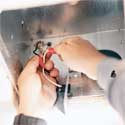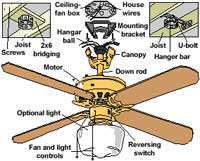
 |
It's important to use the bathroom fan during and after a bath or shower. The excess heat and humidity generated by hot water can promote condensation both inside the bathroom and within the walls around the bathroom, since air is cooler in these locations. If neglected, excessive condensation can promote the growth of mold inside the walls. Resulting mold spores will compromise indoor air quality and may lead to health problems in susceptible people. For proper and professional installation - call 215.949-4626 - that's LaCarrubba Electric. Don't settle for less than the best. |
|---|---|
|
Installing a ventilating fan in your bath will help eliminate fogged-up windows, steamy mirrors and stale odors. But more importantly, it will help prevent moisture-related problems, such as the growth of mold and mildew. The wiring is a critical factor and LaCarrubba Electric does it the right way. Venting options includes running the duct up through the roof or down through the soffit. Note that the fan must always exhaust to the outdoors; never allow the duct to simply blow into an attic, crawlspace or other enclosed area . Run the exhaust duct into the attic and through a sidewall to the outdoors. Bath vent fans are rated by how many cubic feet of air they can move in one minute, known as the CFM rating. To determine which size fan to buy for your bath, multiply the room's square footage by 1.1. For example, a 100-square-foot bath would require a 110 CFM-rated fan.
Use of the ceiling fan in winter, well, seems a bit strange to some, but actually it too can save you money on your heating bills. Heat rises. A large amount of heated air can collect in a large room with high ceilings before it can even be felt. In cold climates, where possible, heater vents are put in the floor. This is the most effective way to heat a room, because the air will rise. In a room with a 16' cathedral ceiling and the thermostat set at 68 degrees F - the uppermost 3 feet can be 90 degrees or higher before the heater shuts off. An incredible waste of energy With the reverse switch set for an upward airflow (clockwise), running your fan on low speed will force the heat accumulated at the ceiling down along the walls where it must rise again. This mild circulation of air provides a more evenly heated room, shortening the time it takes the heater to work. (Low speed is highly recommended to avoid drafts.) Ceiling fan performance and energy savings rely heavily on the proper installation and use of the ceiling fan. Make sure that you use the appropriate UL-listed metal box, marked “For Use With Ceiling Fans.” This outlet box is mounted above the ceiling and also is the point where the fan is attached. This box houses all wiring needed to operate and connect the ceiling fan. If you are replacing a ceiling fixture, most likely you will need to replace the electrical box. For proper and professional installation - call 215.949-4626 - that's LaCarrubba Electric. Don't settle for less. |
|

 In the summer, ceiling fans are very effective at lowering the apparent temperature by making use of evaporation. When you are hot, you perspire, perhaps only a small amount. This is the body's way of cooling off - Evaporation of the perspiration pulls heat away from your body. Circulation of the air rapidly increases evaporation. The more evaporation, the cooler the apparent temperature. This means the thermostat on the A/C can be set higher - saving you money. With the reverse switch set for a downward airflow, in almost all cases this is counter-clockwise (looking up), running your ceiling fan on high speed creates a turbulent column of air. This cone-shaped area of maximum airflow is relative to the area and pitch (angle) of the blades, as well as the RPMs of the motor, hence the three speeds.
In the summer, ceiling fans are very effective at lowering the apparent temperature by making use of evaporation. When you are hot, you perspire, perhaps only a small amount. This is the body's way of cooling off - Evaporation of the perspiration pulls heat away from your body. Circulation of the air rapidly increases evaporation. The more evaporation, the cooler the apparent temperature. This means the thermostat on the A/C can be set higher - saving you money. With the reverse switch set for a downward airflow, in almost all cases this is counter-clockwise (looking up), running your ceiling fan on high speed creates a turbulent column of air. This cone-shaped area of maximum airflow is relative to the area and pitch (angle) of the blades, as well as the RPMs of the motor, hence the three speeds.